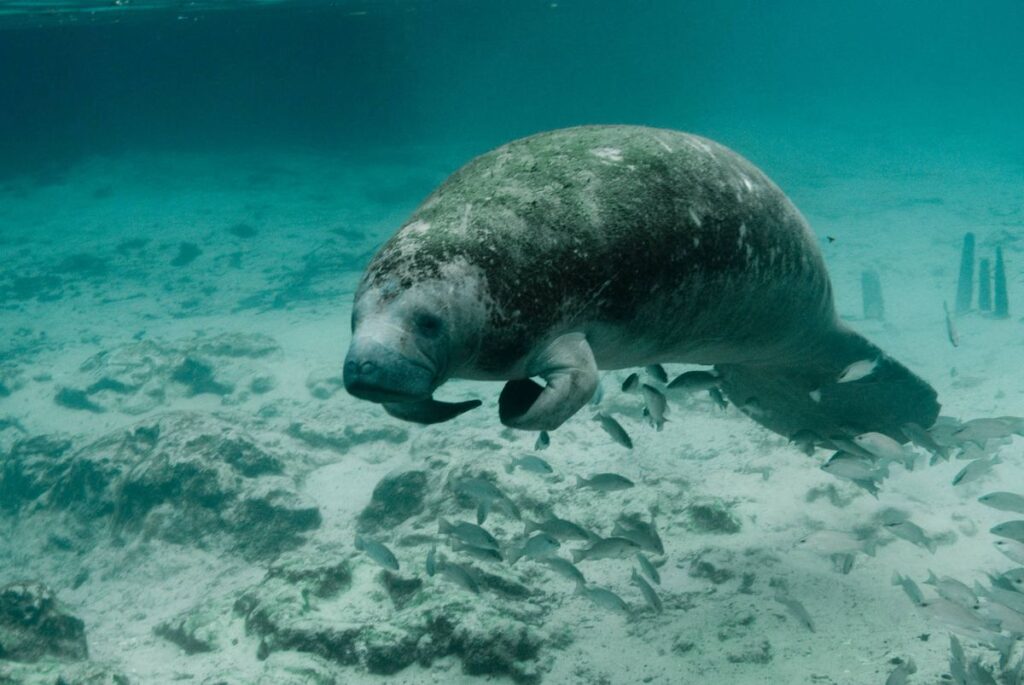Manatees have rebounded since the 1970s but still face myriad threats.
U.S. Fish and Wildlife Service
Manatees are iconic and beloved Florida creatures. But they might be relatively new residents of the Sunshine State.
Research published Wednesday in the journal PLOS One suggests Florida’s manatee populations were once much smaller than they are today. Historically, the gentle “sea cows” visited Florida only occasionally, before returning to their permanent homes in the Caribbean—like tourists. It wasn’t until the 20th century that they became widespread, year-round residents.
“Ultimately, the distribution of manatees was likely much different in earlier times,” says Aarin Allen, an ecologist at Florida International University who was not involved with the research, to National Geographic’s Olivia Ferrari.
To figure this out, a pair of archaeologists studied historical accounts and archaeological reports that described nearly two million animal bones, dating from 14,000 years ago to the late 1950s. Based on what they learned, they were able to piece together a new Florida manatee origin story and timeline.
Over the years, archaeologists have unearthed very few manatee bones in Florida, and the few they have found were modified into tools and ornaments.
“Based on my own experience and talking to other archaeologists, we agreed there was a rarity of manatee bones on archaeological sites,” says study co-author Thomas Pluckhahn, an archaeologist at the University of South Florida, in a statement. “We became more curious and decided to do a comprehensive review of archaeological and archival sources.”
These fossilized bones belonged to precursors of manatees in Tampa Bay. But unfossilized manatee bones are rare throughout Florida’s records from the last 12,000 years, suggesting manatees were once much less common in the state.
Thomas J. Pluckhahn
One possible explanation is that the mammals were there, but Florida’s Indigenous peoples and early European settlers simply weren’t hunting them. This seemed unlikely, though, based on the lack of references to manatees in historical accounts. For example, Spanish explorers arriving in the 1500s—such as Pánfilo de Narváez and Hernando de Soto—made no mention of the large, gentle creatures. Colonial accounts from the 1600s also do not describe manatees.
Manatees start showing up in historical documents in the 1700s, but very infrequently, the researchers find. Even into the late 1800s and early 1900s, manatees were barely mentioned in Florida newspapers. (The southeastern Atlantic coast was an exception, where one writer in 1891 reported that the manatee “abounds.”)
In general, the few instances when sea cows did make headlines suggest they were still novel and rarely seen creatures. In 1893, for instance, the Daily News of Pensacola reported on a dead manatee that had washed ashore. The carcass “will no doubt attract thousands of spectators as soon as its presence becomes generally known,” the newspaper wrote.
In the 1920s and 1930s, newspapers reported on routine manatee sightings on the Atlantic Coast and periodic sightings on the Gulf Coast. By the 1940s and 1950s, sea cows were being spotted throughout much of the state, even becoming a tourist attraction at Everglades National Park.
Based on these findings, researchers deduced that manatees had likely lived year-round in Cuba and other Caribbean locales before becoming a fixture in Florida’s waters. The marine mammals would occasionally venture north to the state, but they always returned back home. Then, in the late 1800s and 1900s, they began inhabiting Florida more regularly, until they became permanent residents.
This shift likely occurred because of changes to Florida’s climate. Before the 1800s, manatees likely found Florida’s waters to be too cold for comfort, thanks to a climate epoch known as the Little Ice Age. This was a period of regional cooling in the North Atlantic that began in the early 1300s and lasted through the mid-1800s. When the Little Ice Age came to an end, Florida started heating up—and manatees began to stick around.
Manatees and tourists share the waters of the Three Sisters Spring in Crystal River, Florida.
Thomas J. Pluckhahn
Today, they’re often found swimming near Florida’s power plants, which regularly discharge warm water. They congregate at these sites throughout the winters to weather the cold season. This same behavior was documented in the late 1800s and early 1900s, when newspapers reported on manatees hanging out in warm areas like canals and yacht basins, as well as near sewage plants.
The study authors believe the proliferation of power plants in Florida in the early 20th century, coupled with the ending of the Little Ice Age, allowed manatees to expand their range northward.
Florida manatees were listed as endangered in 1973, when their numbers dipped below 1,000. But, thanks to decades of concerted conservation work, they were downlisted to threatened in 2017. Today, Florida is home to an estimated 8,350 to 11,730 manatees. However, these marine mammals still face myriad threats—including the loss of seagrass, their preferred food, because of pollution and climate change.
Manatees may also soon lose their artificial warm water habitats as coal and gas power plants close amid the energy transition. Conservationists must now carefully balance the needs of manatees with the goal of switching to renewable energy sources.
“It is one of the most unbelievable human-wildlife conundrums I’ve ever seen in my life,” Elizabeth Fleming, a conservationist with the nonprofit Defenders of Wildlife, told the BBC’s Lucy Sherriff in April. “We have totally reengineered their whole habitat.”


